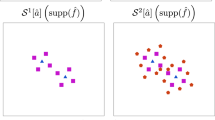Abstract
This article complements the author’s recent work [Numer. Math. 98, 731–759 (2004)] on the regularity of the electronic Schrödinger equation in Hilbert spaces of mixed derivatives. It has been shown there that the solutions of this equation are surprisingly smooth and possess square integrable mixed weak derivatives of order up to N+1 with N the number of electrons across the singularities of the interaction potentials, and it has been claimed that this result can help to break the complexity barriers in computational quantum mechanics using correspondingly antisymmetrized sparse grid trial functions. A construction of this kind that can be interpreted as a sparse grid sampling theorem is sketched here.
Similar content being viewed by others
References
Agmon, S.: Lectures on the Exponential Decay of Solutions of Second-Order Elliptic Operators. Princeton: Princeton University Press, 1981
Atkins, P.W., Friedman, R.S.: Molecular Quantum Mechanics. Oxford: Oxford University Press, 1997
Babenko, K.I.: Approximation by trigonometric polynomials in a certain class of periodic functions of several variables. Soviet Math. Dokl. 1, 672–675 (1960)
Bungartz, H.J., Griebel, M.: Sparse Grids. Acta Numerica 2004, pp. 1–123
Flad, H.J., Hackbusch, W., Kolb, D., Schneider, R.: Wavelet approximation of correlated wave functions. I. Basics. Journ. Chem. Phys. 116, 9641–9657 (2002)
Fournais, S., Hoffmann-Ostenhof, M., Hoffmann-Ostenhof, T., Østergard Sørensen, T.: Sharp regularity estimates for Coulombic many-electron wave functions. Commun. Math. Phys. 255, 183–227 (2005)
Gårding, L.: On the essential spectrum of Schrödinger operators. J. Funct. Anal. 52, 1–10 (1983)
Garcke, J., Griebel, M.: On the computation of the eigenproblems of hydrogen and helium in strong magnetic and electric fields with the sparse grid combination technique. J. Comput. Phys. 165, 694–716 (2000)
Hackbusch, W.: The efficient computation of certain determinants arising in the treatment of Schrödinger’s equation. Computing 67, 35–56 (2000)
Helgaker, T., Jørgensen, P., Olsen, J.: Molecular electronic structure theory. New York: John Wiley and Sons, 2001
Hunziker, W., Sigal, I.M.: The quantum N-body problem. J. Math. Phys. 41, 3448–3510 (2000)
Luo, H., Kolb, D., Flad, H.J, Hackbusch, W., Koprucki, T.: Wavelet approximation of correlated wave functions. II. Hyperbolic wavelets and adaptive approximation schemes. J. Chem. Phys. 117, 3625–3638 (2002)
Kato, T.: On the eigenfunctions of many-particle systems in quantum mechanics. Commun. Pure and Appl. Math. 10, 151–177 (1957)
Le Bris, C. (Ed.): Handbook of Numerical Analysis, Vol. X: Computational Chemistry. Amsterdam: North Holland, 2003
Messiah, A.: Quantum Mechanics. New York: Dover Publications, 2000
Reed, M., Simon, B.: Methods of Modern Mathematical Physics IV: Analysis of Operators. San Diego: Academic Press, 1978
Shannon, C.E.: A mathematical theory of communication. Bell Sys. Tech. J. 27, 379–423, 623–656 (1948)
Shannon, C.E.: Communication in the presence of noise. Proc. IRE 37, 10–21 (1949)
Simon, B.: Schrödinger operators in the twentieth century. J. Math. Phys. 41, 3523–3555 (2000)
Smolyak, S.A.: Quadrature and interpolation formulas for tensor products of certain classes of functions. Dokl. Akad. Nauk SSSR 4, 240–243 (1963)
Whittaker, J.M.: On the functions which are represented by the expansions of the interpolation theory. Proc. Roy. Soc. Edinburgh 35, 181–194 (1915)
Whittaker, J.M.: Interpolation Function Theory. Cambridge: Cambridge University Press, 1935
Yserentant, H.: On the regularity of the electronic Schrödinger equation in Hilbert spaces of mixed derivatives. Numer. Math. 98, 731–759 (2004)
Yserentant, H.: On the electronic Schrödinger equation. Lecture Notes, Universität Tübingen 2003; accessible via the author’s homepage
Zenger, C.: Sparse grids. In: W. Hackbusch (ed.) Parallel Algorithms for Partial Differential Equations. Proceedings, Kiel 1990, pp. 241–251. Notes on Numerical Fluid Mechanics vol. 31, Braunschweig Wiesbaden: Vieweg, 1991
Author information
Authors and Affiliations
Corresponding author
Rights and permissions
About this article
Cite this article
Yserentant, H. Sparse grid spaces for the numerical solution of the electronic Schrödinger equation. Numer. Math. 101, 381–389 (2005). https://doi.org/10.1007/s00211-005-0581-x
Received:
Published:
Issue Date:
DOI: https://doi.org/10.1007/s00211-005-0581-x



